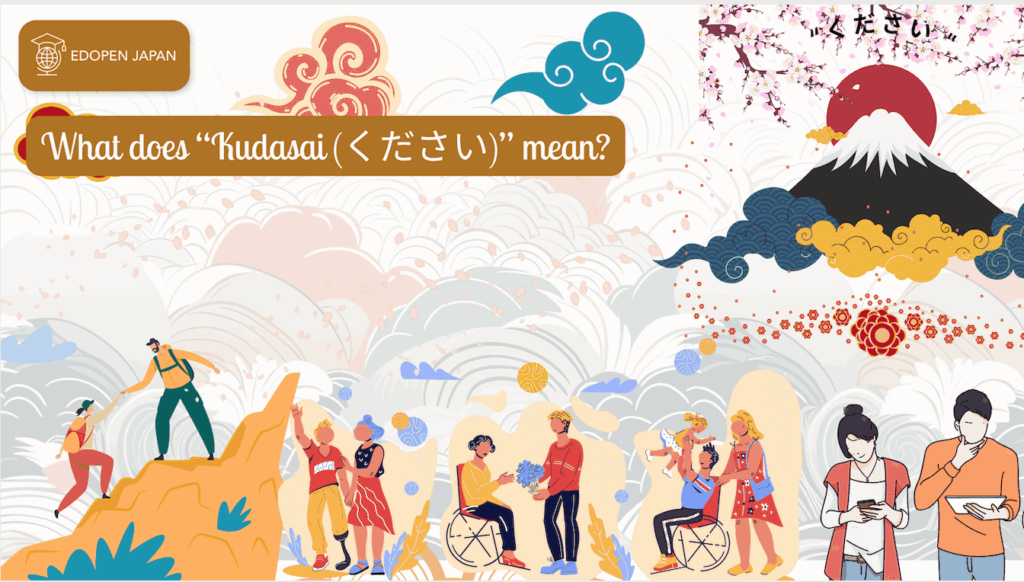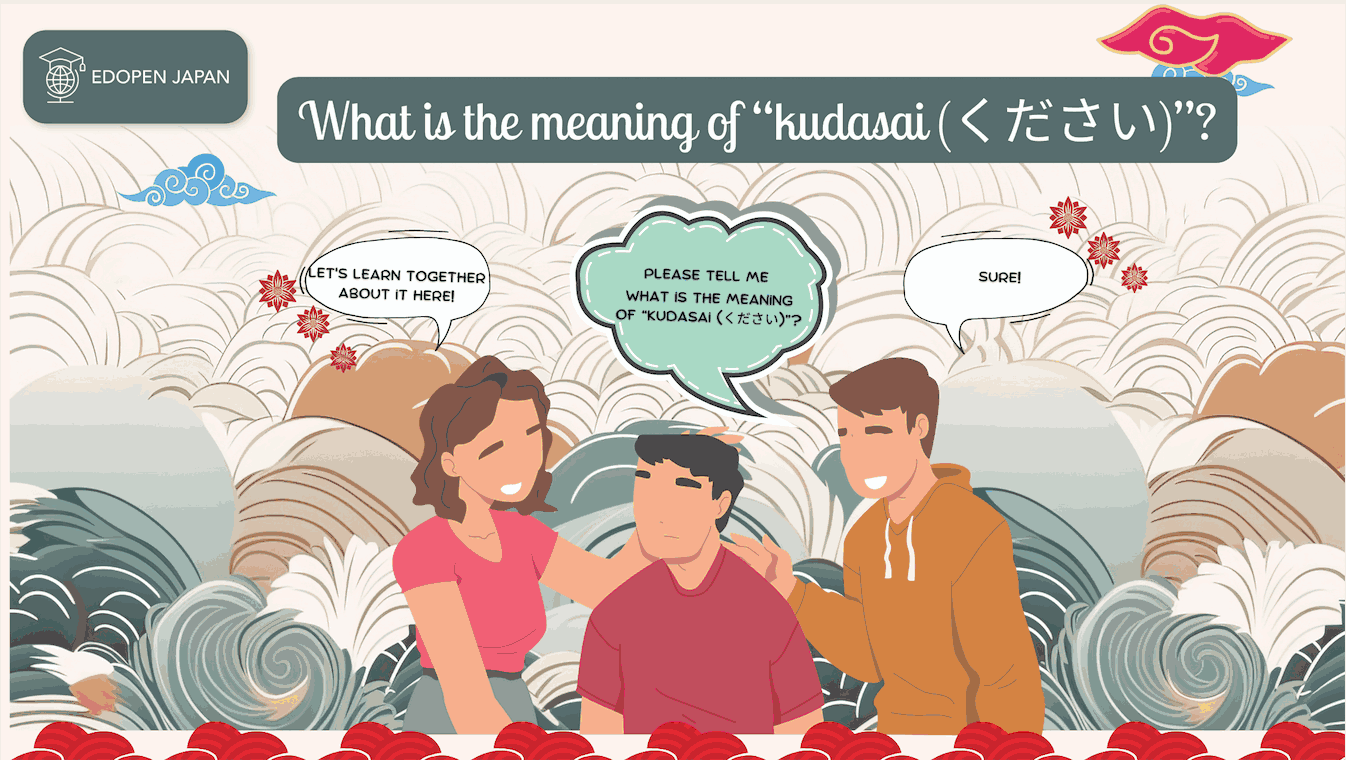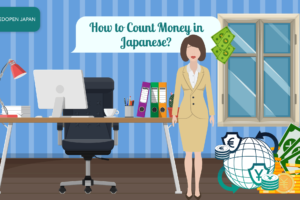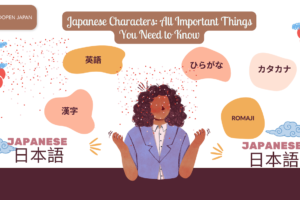In everyday Japanese conversation, you may hear many phrases that are commonly used with the word “kudasai”, such as the following sentences:
- “Omizu wo Kudasai” which means “please give me water”
- “Mite Kudasai ” which means “please look” and so on.
Have you heard these two phrases when you have travelled or been in Japan?
It is usually translated roughly as “please“. However, “kudasai” has different meanings depending on the situation. In many cases, foreigners are confused about the difference between “kudasai” and “onegaishimasu“.
There are some situations where it’s more appropriate to use “kudasai” instead of “onegaishimasu“, and vice versa. Could you tell me when that might be? If you’re not sure, don’t worry! From now on, you can master the phrase “kudasai” as well as “onegaishimasu” completely. Let’s try it!
Also, if someone you have asked for something has done it, you should thank them sincerely. Do you know how to say thank you in Japanese? Check out our discussion on how to say thank you in Japanese below.
Read also:
11 Great Ways to Express Sorry in Japanese
How are You in Japanese: All You Need to Know
The Most Valuable Things to Know about “Wakaranai (分からない)”
Contents
What does “Kudasai (ください)” mean?

Every language represents culture and is influenced by history. First, look at the original meaning. “Kudasai [ください]” is derived from the verb “Kudasaru [くださる]”, which means “give me something”. It is the polite declarative verb that means the same as “Kureru [くれる]”.
After that, “Kudasai [ください]” is used when you want to get something from the other speaker or party. In English, we can translate it as “Please give me (this)”. So, the verb describes the action of the “requestor” and “kudasai” is a word used when asking or urging other people to do something.
So, what does “kudasai” mean in a sentence? Please take a look at the following explanation.
What does the meaning of “Kudasai [ください]” in a sentence?
The meaning of “kudasai” depends on whether it is used as a verb or an auxiliary. There is little difference in meaning and usage. The most famous phrases are the following 3 grammatical patterns.
1. “Kudasai” as a Verb
“Kudasai” as a Verb
Pattern: Noun (N) + を [wo] + Kudasai or “Please give me…”
“Please give me N” is used when you ask someone to give you something (noun). The example of sentences using the above pattern is as follows:
(1) これをください。
Korewo kudasai.
Please give me this.
NOTE: “Nをください” or “Please give me N” is used for people who are lower than you.
Talking about the real case, for a moment: when a teacher asks something from a student, asks for something or a product in a shop, or orders in a restaurant.
(2) 書類のコピーをください。
Shoruino kopi wo Kudasai.
Please give me a copy of the document.
In addition, if you want to ask more politely, use “Kudasaimasennka”, which means “Would you”, as follows
(3) すみません、水をくださいませんか?
Sumimasen, Mizuwo Kudasaimasenka?
Would you please give me some water?
(4) あの、地図をくださいませんか
Ano, Chizuwo Kudasaimasenka?
Hmm, would you please give me a map?
2. “Kudasai” as an Auxiliary verb
“Kudasai” as an Auxiliary verb
Pattern: Verb て [Te] form + Kudasai or “Please…”
The most common “verb +kudasai” meanings are to instruct, to request, and to recommend or allow certain things.
(1) To Give an Instruction
- 20ページを見てください。
20pege wo mite-kudasai.
Please see page 20 of the textbook.
- 田中さん、次を読んでください。
Tanaka-san, tsugi wo yonde-kudasai.
Mr. Tanaka, please read the next (part).
- パスポートを見せてください。
Passport wo misete-kudasai.
Please show your passport.
(2) To Request
- すみませんが、この漢字の読みかたを教えてください。
Sumimasenga, Kono Kanjino Yomikata wo Oshiete-kudasai.
Excuse me, but please tell me how to read this Chinese character.
- すみませんが、あそこの荷物を持ってきてください。
Sumimsasenga, Nimotsuwo Mottekite-kudasai.
I’m sorry, but please bring the luggage there.
- すみませんが、かばんを持ってください。
Sumimasen ga, Kabanwo Motte-kudasai.
I’m sorry, but please bring a bag.
In those sentences you also read the phrase “sumimasen”, please go here to know about this phrase.
(3) To Recommend or Allowing
- どうぞ食べてください。
Douzo, Tabete-kudasai.
Please do not hesitate to eat.
- 残業でおくれるので、先にはじめてください。
Zangyo de okurerunode, Sakini Hajimete-kudasai.
I will be a little late due to overtime, please start first.
- どうぞ、いすに座ってください。
Douzo, Isuni Suwatte-kudasai.
Please sit in a chair.
In addition, let learn more about how to express “Kudasai” or “Please” to be more polite below!
3. “Kudasai” with the Honorific Prefixes
“Kudasai” with the Honorific Prefixes
お [O] or ご [Go] Verb ます [Masu] + Kudasai – “Please…”
This polite phrase is actually having a very close meaning with the word “Recommend” and normally we put “Douzo” at beginning of the sentence. Please see the example below.
(1)どうぞ、お飲みください。
Please drink it.
Douzo, Onomi-kudasai
(2) どうぞ、ごらんください。
Please have a look.
Douzo, Goran-kudasai.
(3) どうぞ、ご自由にお使いください。
Please feel free to use.
Douzo, Gojiyuuni Otsukai-kudasai.
(4)どうぞ、ゆっくりお休みください。
Please take a rest.
Douzo, Yukkuri Oyasumi-kudasai
4. Other usages of “Kudasai”
There are exceptions other than the above usages. Examples are below.
(1) To support → がんばってください。
Please do your best.
Ganbatte-kudasai
(2) Be careful → 気を付けてください。
Please be careful.
Kiwotsukete-kudasai.
(3) Begging → たすけてください。
Please help.
Tasukete-kudasai.
“Ganbatte-kudasai” and “Kiwotsukete-kudasai” are often used in everyday life, and if you are faced with an emergency situation, “Tasukete-kudasai” is the most useful word, so please remember these “Kudasai” phrases.
What is the difference between “Kudasai” [ください] and “Onegaishimasu”[おねがいします]
![What is the difference between “Kudasai” [ください] and “Onegaishimasu”[おねがいします] - EDOPEN Japan](https://global.japanese-bank.com/wp-content/uploads/2023/06/Screen-Shot-2023-06-27-at-6.07.54-AM_11zon-1024x571.png)
Both “kudasai [ください]” and “onegaishimasu [おねがいします]” are Japanese words used to request items. In many cases, these two Japanese words, which roughly translate as “Please” or “Please give me”, are interchangeable.
However, there is a slightly different meaning. There are some situations where it is more appropriate to use kudasai rather than onegaishimasu, and vice versa. In general, the choice between kudasai and onegaishimasu depends on the social context.
Beyond simple translation, they’re used selectively, depending on the tone, context and sentence structure you want to achieve. So when should we use “Kudasai [ください]” and “Onegaishimasu [おねがいします]” in the same situation? And what kind of situations? As I said, “Kudasai” is used as both a verb and an auxiliary.
1. “Kudasai” vs “Onegashimasu”
We can also use “Onegaishimasu” in the same situation and it has the same meaning. Please look at the following example.
Pattern: Nをください translates to “Please give me N.”
- これをください/おねがいします。
Please give me this.
Kore wo Kudasai/Onegaishimasu.
- コーヒーをください/おねがいします。
I will buy a coffee.
Coffee wo Kudasai/Onegaishimasu.
Why you should consider using “Onegaishimasu”?
In addition, please note that “Kudasai (ください) is used to ask someone who is equal to or inferior to the speaker. In Japan and its society, social status, position and age are important, and your position determines the degree of politeness.
Therefore, Keigo (a humble Japanese form used in business or work) is an important part of Japanese culture. A teacher asking a student to do something will use “Kudasai” instead of “Onegaishimasu” because the higher title allows them to speak more casually. The same can be said when ordering as a guest (お客さま) in a shop or restaurant.
It is not good to use “Kudasai” for your manager or supervisor. Instead, use it to ask a friend or someone in a lower position than you, such as your junior at work or school, as follows.
- えんぴつをください。
Give me the pencil.
Enpitsu wo Kudasai.
You may notice that in these examples, “kudasai” feels more like a command, closer to an order, and may feel awkward when used with someone of a higher social status.
2. “Kudasai” is used for only concrete or tangible things
You can only use ~wo Kudasai [~をください] for concrete things. For things like understanding, explanation, or other non-tangible requests, choose “Onegaishimasu” instead. However, you can combine the object with a verb (~te form) and add “Kudasai”. See the example below.
× 説明をください。
An explanation please (wrong).
Setsumei wo kudasai.
〇 説明してください。
Please explain (correct).
Setsumei shite-kudasai.
3. “Kudasai” is more casual when requesting an object
Simply put, “Kudasai” has a more casual (not to be confused with rude) tone than “Onegaishimasu”. It implies a demand and a need, rather than a wish or a request.
Only Use ”Kudasai” for Specific Cases
As we mentioned before, we cannot use “Onegaishimasu” as an auxiliary verb. We can only use “Kudasai” when we need to make sentences with an auxiliary verb.
- Verb て [Te] form + Kudasai, meaning “Please…”
- お[O] or ご[Go] + ます[Masu] Verb + Kudasai which means “Please…”
| 1. ちょっと待ってください | Chotto matte kudasai. | Please wait for a moment. |
| 2. 明日来てください | Ashita kite kudasai. | Please come tomorrow. |
| 3. 助けてください | Tasukete kudasai. | Please help me! |
| 4. ご自由にご覧ください | Gojiyu-ni Goran-kudasai | Please feel free to have a look. |
The Meaning of ”Onegaishimasu [おねがいします]”
![The Meaning of ”Onegaishimasu [おねがいします]" - EDOPEN Japan](https://global.japanese-bank.com/wp-content/uploads/2023/06/Screen-Shot-2023-06-27-at-6.08.05-AM_11zon-1024x578.png)
“Onegaishimasu” [おねがいします] is used to make requests to someone higher than you or a stranger. This is a more passive and humble tone. You’ll find “Onegaishimasu” in other formal phrases: when you’re meeting someone, replying to an email, or working together. It’s more commonly used to ask a favour of a superior or someone you don’t know. This is because “onegaishimasu” is closer to “I beg you” than “would you please”.
- 水をください。
(Give me) water, please.
Mizu wo Kudasai.
- 水をおねがいします。
(A glass of) water, please.
Mizu wo Onegaishimasu.
As you can see in the example, “kudasai” feels more direct. This has to do with Japanese culture. The Japanese are generally indirect communicators. They may be ambiguous when answering questions and making requests to avoid losing face or out of politeness. You can also use “kudasai” for an object, but if you want to be more formal when requesting an object, use “Onegaishimasu” instead.
Use Onegaishimasu only for specific cases and situations
There are some situations where only Onegaishimasu is used. When making a service request, you should use onegaishimasu, as shown in the examples in these two tables.
① Requesting a service you can’t fulfill yourself
- 東京駅まで おねがいします。
To Tokyo Station, please.
Tokyo-eki made Onegaishimasu.
If you’re asking for service for something you can’t do yourself, you can’t use kudasai. In the situation above, you can’t go to Tokyo Station by yourself. Instead, you’ll ask a taxi driver to do it for you.
② Asking to speak to someone on the phone
This is one of the situations where only “Onegaishimasu” is used (the other being asking for a service). When asking to speak to someone on the phone, you can only use “Onegaishimasu”. You can’t ask someone to “give” you a person.
- 田中さんおねがいします。
May I speak to Mr. Tanaka?
Tanaka-san Onegaishimasu.
Similarly, you can’t ask for someone using kudasai, as it’s considered rude.
- べんごし おねがいします。
May I have a lawyer, please.
Bengoshi Onegaishimasu.
③ Calling someone for attention
If you want to call someone or a waiter, you can raise your hand and say “Onegaishimasu” [おねがいします]. And someone should come your way! You can also use “Sumimasen”[すみません] for this. You can also use this phrase when you want to receive your bill.
- お会計おねがいします。
May I get the bill? / Bill please.
Okaikei Onegaishimasu.
④ Request non-tangible objects
“~wo Onegaishimasu” [~をおねがいします] can be used when asking for abstract or intangible things. These include explanations, understanding or cooperation. One example is an expression you’ll often hear on train platforms or in informal announcements.
- ご協力をおねがいします。
We ask for your cooperation.
Gokyouryoku wo Onegaishimasu.
- ご理解をおねがいします。
We ask for your understanding.
Gorikai wo Onegaishimasu.
Please note that we use “Go” [ご] to add a sense of courtesy. In Japanese, it is common to use the prefixes “O”[お] and “Go” [ご] when using Keigo. In short, “Onegaishimasu” is used when you ask someone to help you do something that you cannot do yourself. For example, asking a taxi driver to take you somewhere.
Again, “Kudasai” is probably the more common way of saying please. “Onegaishimasu”, however, is a more polite and formal way of saying please and is technically used when you are asking someone for a favour or when you are asking someone to do something that you cannot do yourself. It can also be used when speaking to a superior or someone you do not know well.
お願いします (Onegaishimasu) is best used when ordering in a restaurant, giving directions to a taxi driver, or requesting a service.
Summary
We can summarise this article in the following points:
- The meaning of kudasai depends on whether it is used as a verb or an auxiliary.
“Kudasai” has 3 meanings [Instruct, Request, and Recommend] depending on the situation. - When “Kudasai” is used as a verb, we can also use “Onegaishimasu” in the same situation and meaning. “Kudasai” is used to ask someone who is equal to or inferior to the speaker.
- “Onegaishimasu” is used to make requests to someone higher than you or to a stranger. “Onegaishimasu” is used when you ask someone to help you do something you cannot do yourself.














Leave a Reply